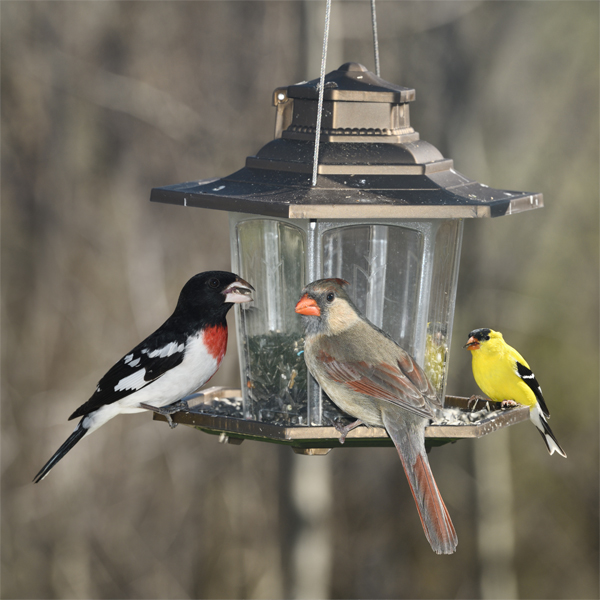“January brings the snow, makes our feet and fingers glow.” So begins Sara Coleridge’s poem about the calendar year, and January’s lines remind us that it is a tough time of year for birds that live in New England.
One way to make things easier for them is to offer supplemental food and water. When planning on feeding birds there are several things to take into consideration.
Types of Feeders
The type of birds you wish to attract will influence the type of feeder you choose. They fall into these categories:
Platform – this is basically a table with a small rim, on which birds can perch and reach down for the food placed on it. It suits all types of birds, particularly ground-feeders.
Hopper – this attracts the largest range of songbirds, and as its name suggests, it dispenses food onto a small platform. It also has its own built-in weather protection, not only for the food, but also for the birds using it.
Tube – this type of feeder is great for finches and other small birds, and can accommodate a number of birds at once.
Wire Mesh – this is good for birds, such as woodpeckers and nuthatches, that don’t need to perch to feed, and includes both nut and suet feeders.
Location of Feeders
Understandably, you will wish to place the feeder where you can observe it from the comfort of indoors, but in order for it to be attractive to birds, keep these factors in mind:
Safety – birds need to feel that the feeder is in a location safe from predators. This means locating it within 10-15 feet of a tree or bushes, where birds can readily retreat if they feel there is danger. General environment does influence this though. Birds used to living in urban settings will have different attitudes to what constitutes danger and safety compared to those in rural locations.
Comfort – try to locate the feeder where it is sheltered from the worst of winter winds. Birds will not wish to use your feeders if doing so has them buffeted by strong gusts.
Protection from squirrels – locating a feeder can often leave it readily accessible to squirrels, as they are capable of leaping 10 feet from trees in order to land on feeders. There are two ways to handle this.
Deterrents can take the form of baffles either hanging over the feeder, which prevent squirrels leaping onto the feeder, or as part of the pole supporting the feeder, which prevents squirrels climbing up to the feeder.
Feeders themselves can also have design features to prevent squirrels from accessing bird food. Most commonly they consist of weight-sensitive perches, which when something heavy (squirrel) sits on the perch, access to the feeding port is closed; or the food is in a cage which only small birds can access. These methods also deters large birds taking food meant for smaller birds. And if you wish to feed the squirrels too, offer them things such as corn cobs, fruit and unshelled peanuts on the ground.
You can also discourage squirrels by offering food such as nyjer and saff flower seed, or by buying seed which has been treated with hot pepper, something which birds’ palates cannot sense. In addition to seeds and nuts, unsalted peanut butter, suet and fruit such as apples are all good choices for birds.
It is also important to keep feeders clean. Not only do birds dislike moldy food, but dirty food and feeders can harbor dangerous bacteria and make birds sick. Aim to clean your feeders at least once a month with a 10% solution of bleach and warm water.
Lastly, do not neglect to offer a source of drinking water, if there is no natural source nearby.
When temperatures drop below freezing, either plan on putting put fresh water daily, or invest in a birdbath de-icer.
Sources: lyricbirdfood.com








